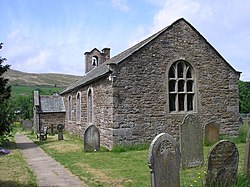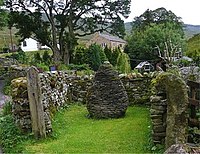Outhgill: Difference between revisions
Created page with "{{Infobox town |name=Outhgill |county=Westmorland |picture=St Mary's Church, Outhgill - geograph.org.uk - 187864.jpg |picture caption=St Mary's Church, Outhgill |os grid ref..." |
No edit summary |
||
| Line 22: | Line 22: | ||
St Mary's Church was founded by Lady Ideonea de Veteripont in the 14th century (possibly 1311) but was restored, in fact more or less rebuilt, in 1663 by Lady Anne Clifford, as the plaque above the door relates. The simple, dignified interior contains an 18th-century font, a faded coat of arms of Lady Anne from the year she restored the church, a set of shelves that used to hold the loaves of bread distributed weekly under Middleton's Charity, and kneelers embroidered by ladies of the dale. The stained glass windows all date from Victorian times or later. | St Mary's Church was founded by Lady Ideonea de Veteripont in the 14th century (possibly 1311) but was restored, in fact more or less rebuilt, in 1663 by Lady Anne Clifford, as the plaque above the door relates. The simple, dignified interior contains an 18th-century font, a faded coat of arms of Lady Anne from the year she restored the church, a set of shelves that used to hold the loaves of bread distributed weekly under Middleton's Charity, and kneelers embroidered by ladies of the dale. The stained glass windows all date from Victorian times or later. | ||
In the churchyard are the unmarked graves of 25 of the builders of the Mallerstang section of the [[Settle–Carlisle line|Settle-Carlisle Railway]], and members of their families, who died during the construction of the line. A monument to them, marking the area where they are buried, was dedicated in 1997. | |||
In the churchyard | |||
Almost opposite the church is the former Wesleyan Chapel, built in 1878. | Almost opposite the church is the former Wesleyan Chapel, built in 1878. | ||
| Line 30: | Line 29: | ||
There are about a dozen houses, including one where the father of the great scientist Michael Faraday was the blacksmith in the late 18th century; he moved to [[London]] in the year Michael was born. | There are about a dozen houses, including one where the father of the great scientist Michael Faraday was the blacksmith in the late 18th century; he moved to [[London]] in the year Michael was born. | ||
[[File:Pinfold | [[File:Pinfold in Outhgill, Westmorland.jpg|left|thumb|200px|The Pinfold, Outhgill (with sculpture by Andy Goldsworthy]] | ||
There is a replica of the "Jew Stone" on the village green. The original monument was set up by the rather eccentric William Mounsey in 1850 on Black Fell Moss below [[Hugh Seat]], to mark the source of the [[River Eden, Cumberland and Westmorland|River Eden]]. It got its name from the inscriptions in Greek and Hebrew. | There is a replica of the "Jew Stone" on the village green. The original monument was set up by the rather eccentric William Mounsey in 1850 on Black Fell Moss below [[Hugh Seat]], to mark the source of the [[River Eden, Cumberland and Westmorland|River Eden]]. It got its name from the inscriptions in Greek and Hebrew. | ||
Latest revision as of 20:36, 15 September 2017
| Outhgill | |
| Westmorland | |
|---|---|
 St Mary's Church, Outhgill | |
| Location | |
| Grid reference: | NY781016 |
| Location: | 54°24’36"N, 2°20’10"W |
| Data | |
| Post town: | Kirkby Stephen |
| Postcode: | CA17 |
| Dialling code: | 017683 |
| Local Government | |
| Council: | Westmorland & Furness |
| Parliamentary constituency: |
Penrith and The Border |
Outhgill is a hamlet on Mallerstang Common in southern Westmorland. It stands about five miles south of Kirkby Stephen.
This is the main hamlet in the dale of Mallerstang, and retains the Norse pattern of its original settlement: a series of small hamlets and isolated houses, with no village centre. In the 19th century, as the main hamlet at the centre of the dale, Outhgill had an inn, a post office, a smithy, the parish church and a Methodist chapel. Of these, only the church survives.
Churches
St Mary's Church was founded by Lady Ideonea de Veteripont in the 14th century (possibly 1311) but was restored, in fact more or less rebuilt, in 1663 by Lady Anne Clifford, as the plaque above the door relates. The simple, dignified interior contains an 18th-century font, a faded coat of arms of Lady Anne from the year she restored the church, a set of shelves that used to hold the loaves of bread distributed weekly under Middleton's Charity, and kneelers embroidered by ladies of the dale. The stained glass windows all date from Victorian times or later.
In the churchyard are the unmarked graves of 25 of the builders of the Mallerstang section of the Settle-Carlisle Railway, and members of their families, who died during the construction of the line. A monument to them, marking the area where they are buried, was dedicated in 1997.
Almost opposite the church is the former Wesleyan Chapel, built in 1878.
About the village
There are about a dozen houses, including one where the father of the great scientist Michael Faraday was the blacksmith in the late 18th century; he moved to London in the year Michael was born.

There is a replica of the "Jew Stone" on the village green. The original monument was set up by the rather eccentric William Mounsey in 1850 on Black Fell Moss below Hugh Seat, to mark the source of the River Eden. It got its name from the inscriptions in Greek and Hebrew.
Pendragon Castle is a mile or so to the north at NY779025. Local legend tells that the castle was founded by King Arthur's father, Uther Pendragon. It is however of the Midlde Ages, albeit that the remains of a Roman camp have been found nearby.
A smaller hamlet, Shoregill, is half a mile to the south-west.
Outside links
| ("Wikimedia Commons" has material about Outhgill) |
References
- Hamilton, John: 'Mallerstang Dale' (Broadcast Books, 1993; reprinted 1999)
